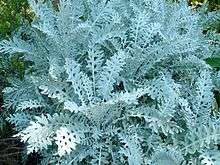Centaurea cineraria
| Centaurea cineraria | |
|---|---|
 | |
| Scientific classification | |
| Kingdom: | Plantae |
| (unranked): | Angiosperms |
| (unranked): | Eudicots |
| (unranked): | Asterids |
| Order: | Asterales |
| Family: | Asteraceae |
| Tribe: | Cynareae |
| Genus: | Centaurea |
| Species: | C. cineraria |
| Binomial name | |
| Centaurea cineraria L. | |
| Synonyms | |
| |
Centaurea cineraria, the velvet centaurea, is – like some other plants – also known as "dusty miller" and "silver dust". It is a small plant in the family Asteraceae and originates from the Island of Capraia in Italy, where it is called fiordaliso delle scogliere.[3]
The mature plants will grow from 15 cm to 60 cm (6inches to 24 inches). They prefer full sun, but will tolerate light shade, and also prefers average to rich well-drained soil.
Centaurea cineraria will produce small white or yellow flowers in summer, but these are usually trimmed because the plant is normally grown as foliage.
Depending on climate, it can be grown as either an annual or as a perennial.
Common varieties include: "Silver Dust", "Silver Lace" and "Cirrus". The image above the scientific classification is a plant of the "Silver Lace" variety.
References
- ↑ Euro+Med Plantbase lists Centaurea gymnocarpa as an accepted species, while the Global Compositae Checklist lists it as a synonym of Centaurea cinerea. The IUCN Red List of Threatened Species, Version 2014.1, states "C. gymnocarpa belongs to the ... "cineraria" group ... probably was once a single species, ... but as islands were formed, new species evolved on each island."
- ↑ Germplasm Resources Information Network (GRIN) (1992-05-20). "Taxon: Centaurea cineraria L." (HTML). Taxonomy for Plants. USDA, ARS, National Genetic Resources Program, National Germplasm Resources Laboratory, Beltsville, Maryland. Retrieved 2008-03-03.
- 1 2 Botanic Garden and Botanical Museum Berlin-Dahlem. "Details for: Centaurea cineraria" (HTML). Euro+Med PlantBase. Freie Universität Berlin. Retrieved 2008-03-03.
- Ellis, Barbara W., "Taylor's Guide to Annuals, How to Select and Grow More Than 400 Annuals, Bienniels, and Tender Perenniels", 1999 Haughton Mifflin Company, New York, NY
- Armitage, Allan M., "Armitage's Manual of Annuals, Bienniels, and Half Hardy Perenniels", illustrated Asha Kays and Chris Johnson, 2001 Timber Press Inc., Singapore